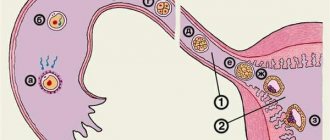Unfortunately, not all women are able to give birth on their own at term. This can threaten the fetus with post-maturity and all the ensuing consequences. To prevent such a situation, they are induced artificially for the woman in labor. A fairly popular drug for this purpose is the drug mifepristone. In order to correctly assess the state of affairs, it would be nice for a woman to know how long it takes for mifepristone to act to induce labor, how it works, what sensations it causes and what contraindications it has.
Purposes and features of application
In fact, the process of bringing a child into the world is a natural procedure; in practice, anything can happen. Extended pregnancy, absence of contractions after water breaks, weak labor, elongation of the uterus due to multiple pregnancies and a number of other indications for which stimulation is used. In addition to caesarean section, drug therapy is used, in particular mifepristone tablets to induce labor.
Stimulation of labor with a pill has recently become very popular among doctors. They contain artificially synthesized antigestogens. After taking the pills, the balance of hormones changes towards estrogen, the uterus matures and opens - the usual process begins.
Mifepristone has been used recently to induce labor; before that, many women used it for medical abortion - termination of pregnancy in the early stages (up to 42 days). Partly because of this, many patients experience some fear and wariness when the expression mifepristone for inducing labor is mentioned.
Important! Mifepristone should be taken to initiate labor only under the supervision of a doctor and exclusively as directed and in a hospital setting. No independent actions can be taken to speed up the birth of a child.
Mifepristone for preparing the cervix for childbirth has an effect on lactation. The instructions for the drug clearly state that breastfeeding should be stopped for 14 days.
After the expiration date, renewal is possible. It is prohibited to use mifepristone during pregnancy with a uterine scar. Such use of the drug threatens uterine rupture; the likelihood of suture divergence during stimulation is several times higher than during natural stimulation.
Is it dangerous for the fetus?
The effect of medication taken in the first trimester on the fetus has not been fully studied. As medical practice shows, in 2% of cases, after using these pills to terminate a pregnancy, the fertilized egg is not rejected, and the pregnancy continues. In this case, it is necessary to resort to other types of abortion - vacuum or surgical.
If a woman nevertheless decides to continue such a pregnancy, then all responsibility for the health of the unborn baby falls entirely on her.
The instructions for the drug indicate that if it is used to terminate pregnancy in the early stages, there is a risk of developing congenital defects in the fetus. That is why doctors categorically do not recommend continuing a pregnancy during which this drug was used.
If the pills are used late in pregnancy, when the baby is already fully formed, they will cause absolutely no harm to his health. Therefore, if an urgent need arises, you can safely use this drug to induce labor.
After using Miropriston, most patients gave birth within 1-2 days. It should be noted that this medicine is not sold in pharmacies. It can only be used in a hospital setting, and the admission process must be supervised by a gynecologist. Before prescribing pills, the doctor must find out whether the pregnant woman has pathologies for which this drug is contraindicated.
From taking the pill to birth
If stimulation is necessary, there are no contraindications and the doctor has chosen this drug, the action plan is usually as follows.
On the first day, take 1 tablet with a concentration of 200 mg of the active substance. After 24 hours, repeat the indicated dose. In most cases, patients note that the drug begins to act on the first day. This entire period should take place under the supervision of a doctor, since at the moment when contractions begin after mifepristone, additional prescriptions of oxytocin or other drugs may be necessary.
How long does it take for a pill to induce labor to work? Everything is very individual, since the indications for taking the drug vary. On average, mifepristone during childbirth begins to act in the first 24 hours after administration. These are mild nagging pains in the lower abdomen, which gradually intensify after the second tablet and reach their climax on the third day - the child is born.
When induction of labor with mifepristone is used, the 2nd tablet may not be needed; the first cramping sensations occur after 6-7 hours. In such cases, everything goes quickly, contractions increase intensely and the whole process ends before the second dose is taken.
In most cases, experienced mothers who have had labor stimulated with mifepristone note that the process of bringing a child into the world is more nervous and stressful. But, such a condition can arise due to the influence of the psychological state of the woman in labor. Otherwise, the birth itself after mifepristone is not much different from the usual ones - contractions, pushing, birth of the fetus, delivery of the placenta.
How long does it take for the pills to start working?
In the absence of contraindications and the need to take the drug arises, the patient is given 200 mg of Miropriston. If labor does not begin within 24 hours, the woman needs to take another dose of the drug.
The exact time of the onset of intense contractions after taking the pills cannot be predicted. Therefore, the doctor constantly monitors the patient and the fetus. If contractions are absent within three days after taking the first tablet, the woman in labor is prescribed Oxytocin.
After taking the pills, the patient experiences pain in the lower back, and the plug may come out. After some time, severe pain occurs, which is a harbinger of the onset of labor.
Women who use Miropriston to intensify labor should take into account that the process of artificial stimulation provokes extremely painful contractions.
In the process of monitoring the patient’s condition, the doctor must determine the moment of change in the uterus, which was hard before taking the pills, and then begins to gradually soften and acquire elasticity. When the cervix opens more than 1-2 fingers, intense contractions begin.
Indications for induction of labor
Childbirth is a natural process in the life of any woman. There are times when it is impossible to do without medical intervention and stimulation of labor. That is why many expectant mothers are interested in what pills are used to induce labor in the maternity hospital and how dangerous they are for the child’s life.
The doctor may offer induction of labor if the patient has indications for such a procedure:
- post-maturity of the fetus;
- absence of contractions after the rupture of amniotic fluid;
- presence of serious chronic diseases;
- multiple pregnancy;
- polyhydramnios.
All of these signs, in the absence of professional intervention, can harm not only the mother herself, but also her child.
Doctors often recommend premature induction of labor if the condition of the fetus worsens sharply. Most often, experts insist on a caesarean section.
It is worth noting that pills that induce labor can only be taken as prescribed by a doctor. This is no coincidence, because they have a number of contraindications. Artificially induced contractions are much more painful and stronger than natural ones. In combination with pills that induce labor, a specialist must prescribe pain relief.
When is labor induction used?
If a woman is unable to give birth on her own, the obstetrician takes measures to stimulate labor. Stimulation may be required in the following cases:
- The size of the fetus is too large due to polyhydramnios.
- The mother in labor has diabetes mellitus.
- Post-term pregnancy, aging of the placenta and oxygen starvation of the baby.
- Prolonged stay of the fetus in the womb after the water breaks.
- No contractions during childbirth.
- Exhaustion of the woman in labor.
Contraindications to artificial induction of labor
Absolutely any medical procedure has a number of contraindications. Artificial induction of labor is no exception. If a woman in labor had a cesarean section during a previous pregnancy, then pills that induce labor are contraindicated for her. Artificial stimulation can lead to rupture along the old seam. Artificial induction of labor is also contraindicated if the fetus is large, its growth and development stops, and also if the pregnant woman has diabetes, intrauterine bleeding, placental abruption, or an infectious disease of the uterus. If at least one of the above signs is present, labor induction is not prescribed.
General information about the drug to induce labor
Tablets that induce labor contain artificially synthesized antigestagens. These medications block some intrauterine processes. The hormones contained in the tablets lead to accelerated development of labor. They help open the cervix.
Previously, pills that induce premature labor were used for emergency contraception after fertilization. These drugs are known as abortifacients.
It is for this reason that many women believe that the pills have a negative effect on the child. Before taking such a drug, it is imperative to consult a specialist.
"Mifepristone." Indications for use
Pills that induce labor have become especially popular lately. Mifepristone is the most popular drug among those women who are recommended to artificially induce labor.
Mifepristone is a synthetic drug that does not have gestagenic activity. It is used not only to stimulate labor, but also to interrupt it in the early stages and emergency contraception. Under the influence of this drug, progesterone receptors are blocked. Its entry into the body stimulates the expulsion of the fertilized egg from the uterine cavity.
10 milligrams of the drug is prescribed if there has been unprotected sexual intercourse within 48 hours and there is a risk of unwanted pregnancy.
Experts note that the effectiveness of Mifepristone is 99%. This drug prevents the placement of a fertilized egg on the walls of the uterus. To determine whether the medicine has worked or not, you need to visit a gynecologist and get tested, or wait for your menstrual flow. They must occur no later than three days after taking Mifepristone.
200 or 600 milligrams of the drug can be prescribed by a doctor if the patient has an unwanted pregnancy for up to 42 weeks and wants to get rid of it with medication. The effectiveness of the drug is 98%. It is worth noting that this method should never be used independently at home. "Mifepristone" provokes fetal death. This abortion method entails serious complications in the woman’s body.
200 milligrams of the drug can also be prescribed if a pregnant woman is recommended to use the method of artificial stimulation of labor. It is believed that pills that induce labor do not pose a danger to the life and health of mother and child in the long term. However, there are many cases where it was drugs that caused serious complications.
How does Mifepristone work in the body?
The drug is a synthetic hormone, a steroid from the group of antigestagens; Externally, mifepristone is a yellow powder with a greenish tint. The action of the drug is based on suppressing the synthesis of progesterone, one of the main hormones of pregnancy; we can say that mifepristone is a progesterone antagonist.
Use the product for:
- artificial termination of pregnancy at an obstetric period of up to 42 days;
- stimulation of labor when the pregnancy is full term;
- contraception after unprotected sexual intercourse (within three days);
- therapy for uterine leiomyoma, a benign tumor.
How the drug will help induce labor
In order for labor to begin, the level of progesterone, the pregnancy-protecting hormone, naturally decreases in the female body; for nine months, progesterone helped the fetus grow and develop, and prepared the mother’s body for childbirth. And when it’s time for the baby to leave the womb, the mature placenta stops synthesizing the hormone. He completed the task.
But sometimes the amount of progesterone does not decrease before childbirth; the woman is at risk of post-term pregnancy. In such a situation, mifepristone will help, which will block the production of progesterone and provide the hormonal background necessary for the onset of labor. Under the influence of the antigestagen, the muscle activity of the uterus increases and the labor process starts - the mucous plug comes off, followed by water; Contractions of the required intensity begin.
According to medical statistics, in four out of five patients who were given Mifepristone, labor began within two days after the start of therapy.
When is it prescribed?
The hormonal drug is used to stimulate labor in women whose pregnancy is 41 or 42 weeks, and there is no sign of the onset of labor; Doctors have not yet diagnosed a post-term pregnancy, but it’s time to give birth. When the pregnancy exceeds 40 weeks and there are no signs of the onset of labor, the likelihood of drug stimulation of the process increases
Deaths after taking pills that induce labor
Today, almost every woman knows which pills induce labor. This is no coincidence, because they are prescribed not only to late-term mothers, but also to girls who have had unprotected sexual intercourse or have an unplanned pregnancy. There are many cases where the use of such tablets caused death.
In September 2001, a woman died a week after taking Mifepristone. The cause of death was septic shock, which was caused by infection of the uterus.
On September 12, 2001, a resident of the United States of America died 5 days after taking Mifepristone. She had an ectopic pregnancy. It is known that in this case, stimulation of labor is prohibited. The cause of death was the negligence of doctors who did not immediately notice the ectopic development of the fetus. When the woman came home after the medical abortion procedure, she began to experience severe pain and heavy bleeding. She called her doctor several times, but he assured her that these were natural symptoms. A few hours later she was hospitalized and operated on, but she died from a ruptured fallopian tube.
In the summer of 2003, a resident of Sweden died as a result of a medical abortion. She received qualified medical care. The specialist told her which pills induce labor and how to take them correctly. A week after the examination, the girl took Mifepristone. A few days later she was given a prescription for another drug. After taking it, the girl began to experience severe pain and heavy bleeding. At the hospital she was injected with painkillers and given first aid. 6 days later her body was found in the shower. The cause of death was bleeding.
Instructions
Miropriston tablets are used only in medical institutions that are equipped with special equipment, under the supervision of a doctor. In the presence of a specialist, a woman takes 3 tablets (600 milligrams of mifepristone in total) once, washed down with boiled water.
The drug must be used 1–1.5 hours after breakfast. After 36 to 48 hours, the patient should return to the hospital to use misoprostol at a concentration of 0.4 milligrams.
After 10–14 days, an examination is carried out. If necessary, hormone levels are determined to confirm that the pregnancy has terminated.
According to the instructions and reviews of “Miropriston” for inducing labor, it is known that if after two weeks the effect is not observed, mandatory vacuum aspiration and subsequent histological examination are prescribed.
Preparing for childbirth:
- In the presence of a doctor, the expectant mother takes one Miropriston tablet. A day later, the procedure is repeated.
- After another three days, the birth canal is assessed, and if necessary, Oxytocin or prostaglandins are used.
Duration of action of the drug. Features of application
Many girls are interested in how long it takes for a pill to induce labor to take effect. Few people know, but the drug works on an individual basis. The time after which it begins to act depends on many indicators of the expectant mother’s body. However, there is an average of 24 hours.
If the first tablet does not work, you need to take a second one a day later. It is worth noting that the drug should only be used under the supervision of a specialist. If the drug does not work the second time, the doctor prescribes a stronger drug.
Instructions for use
Miropriston is used only under the strict supervision of a physician in a hospital setting. To induce labor, women are prescribed 1 tablet at a dosage of 200 mg every 24 hours.
In between appointments, the doctor evaluates changes occurring in the area of the birth canal. If necessary, the patient is prescribed additional drugs - Oxytocin or prostaglandins.
After using Miropriston, the following side effects may develop:
- pain and discomfort in the lower abdomen,
- dizziness,
- hives,
- headache,
- hyperthermia,
- nausea and vomiting.
An overdose of the drug can lead to adrenal insufficiency. The use of Miropriston does not have a negative effect on subsequent lactation.
Reviews about tablets
Many women know that there is a pill that induces labor. Reviews from experienced mothers in labor can help expectant mothers find out how dangerous this method of stimulation is. Many girls see only advantages in such pills. They claim that the drug affects the body in the shortest possible time.
There are many experienced women in labor who claim that the drug did not help them. Because of this, they had to resort to a caesarean section. In addition, they believe that the drug is unusually dangerous not only for women, but also for newborns. They do not recommend artificially stimulating labor.
As you can see, all reviews are different. For some, pills that induce labor in the hospital are suitable, but for others, they are not. It is for this reason that such a drug should only be prescribed by a doctor.
Cost of tablets
For many girls, an important criterion when choosing a method of inducing pregnancy is cost. The price of tablets that speed up labor is about 2 thousand rubles per 200 grams.
A package of Mifepristone will cost a girl 1,000 rubles per tablet. The drug has a light yellow color. The shelf life is three years. Mifepristone has a cheaper analogue - Misopristol. It is less effective. The cost of Misopristol ranges from 300 to 1950 rubles. The drug is available only with a prescription. The shelf life is no more than 2 years.
Another analogue is “Pencrofton”. Its cost ranges from 1500 to 3000 rubles. You can purchase it at a pharmacy only if you have a doctor’s prescription. It is worth noting that this medicine can only be found on the territory of the Russian Federation.
Induction of labor at home
Some girls believe that pills that induce labor are extremely dangerous to their health. As a rule, such women in labor are interested in how labor can be accelerated at home without the use of medications.
The most popular and effective way to induce labor is sexual intercourse. It is worth noting that the main criterion for this method is the entry of sperm into the woman’s body. It is the male seminal fluid that contains prostaglandins. They increase the contractile activity of the uterus. To stimulate labor at home, many girls use a fruit cocktail. It consists of a glass of orange juice in equal quantities with mineral water, as well as 2 tablespoons of castor oil and almonds.
We strongly do not recommend resorting to induction of labor at home. Such actions can harm not only the newborn, but also the mother in labor.










